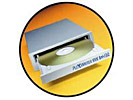Pre-recorded music or software CDs have physical pits in the surface. A cd player or cd-rom drive reads the CD by shining a low power laser on the spinning disc and measuring the amount the laser reflects. A pit will reflect less light than a section with no pit. Recordable CDs also have sections that reflect more or less light. Instead of pits, though, these sections are created by burning a dye on the disc with a high power laser, which creates dark and light sections. On this page, we try to describe how a rewriteable CD works, since both pre-recorded and recordable CDs use very permanent mechanisms for writing the disc.
Essentially, rewriteable CDs need to have dark and light sections, but the process of creating the sections need to be reversible. One needs to be able to turn a dark spot into a light spot and vice versa. In addition, a rewriteable CD needs to be recordable using the same physical equipment as a normal recordable CD. The way it works is that CD-RW discs have a layer of alloy on them, instead of the dye that a CD-R has. The alloy has two states: a crystalline state and an amorphous state. These two states are analogous to sand and glass. Both are the same material, but they have different optical properties. On the CD-RW, the alloy’s crystalline state reflects light well, while the amorphous state does not. This alloy has the additional benefit that one can change the state of the alloy by heating it to different temperatures using different intensity lasers. A high power laser writes amorphous spots on the disc. An intermediate power laser writes crystalline spots. A CD-RW’s alloy can be re-written approximately 1,000 times, and normally should store its data for about 30 years.
Some people have floated a theory that there really are no CD-R’s sold these days. The theory says that it must be more economical to create only one kind of CD (the CD-RW), and simply label them as recordable or rewriteable. By making only one kind of CD, the producer can eliminate dual sets of manufacturing equipment. This theory probably does not hold water though. It really is cheaper to make both kinds of discs.

